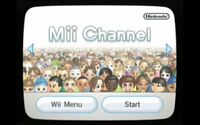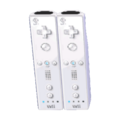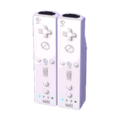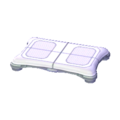Difference between revisions of "Wii"
AlexBot2004 (talk | contribs) m |
|||
| (32 intermediate revisions by 14 users not shown) | |||
| Line 25: | Line 25: | ||
| successor = [[Wii U]] | | successor = [[Wii U]] | ||
}} | }} | ||
| − | The '''Wii''' is [[Nintendo]]'s fifth home gaming console and | + | The '''Wii''' is a home gaming console and is [[Nintendo]]'s fifth home gaming console. The Wii became known for its controller, called the Wii Remote, which has motion and tilt sensitivity, and a plug for control extensions on the bottom. The Wii Remote also had a pointer functionality for menu selection, such as managing [[inventory]] slots in {{CF}}. |
| + | |||
| + | The Wii's original model, featuring GameCube backward compatibility, was released in 2006 and discontinued in 2013. Two redesigned models for the Wii were released: the '''Wii Family Edition''', which was released in 2011 and removed GameCube compatibility, and '''Wii Mini''', a cheaper model with no online connectivity released in 2013. Both revisions have since been discontinued. | ||
| + | |||
| + | The console had a mainline installment in the {{SER}}, titled {{CF}}, released on November 16, 2008 in the United States and on December 5 for PAL regions. | ||
| + | |||
| + | The Wii sold 101.63 million<ref>https://www.nintendo.co.jp/ir/en/finance/hard_soft/index.html</ref> units worldwide and held the title of being Nintendo's best selling home console up until 2021 where the [[Nintendo Switch]] surpassed it by selling 103.54 million units. | ||
==Controllers== | ==Controllers== | ||
| − | The Wii has various methods of inputting commands like the Wii Remote, Nunchuk, Classic Controller, and the GameCube ([[Nintendo GameCube|GCN]]) controller. Most games that | + | The Wii has various methods of inputting commands like the Wii Remote, Nunchuk, Classic Controller, and the GameCube ([[Nintendo GameCube|GCN]]) controller. Most games that were released supported these functions by giving the player optional input method like Wii Remote turned horizontally |
| − | Special controllers have been released for this console, like the Wii Balance Board, | + | Special controllers (which are not compatible with {{CF}}) have been released for this console, like the Wii Balance Board, primarily used for the best-selling {{wp|Wii Fit}}. The Wii Wheel is a plastic shell that came with ''[[mariowiki:Mario Kart Wii|Mario Kart Wii]]'' that allows the Wii Remote to sit in comfortably and provides the player with a better gaming experience. The Wii Zapper came with ''[[zeldawiki:Link's Crossbow Training|Link's Crossbow Training]]'' and is primarily used for first-person shooters such as ''{{wp|Resident Evil 4: Wii Edition|Resident Evil 4}}''. The Wii MotionPlus, was released in June 2009 and was included with ''{{wp|Wii Sports Resort}}''. The MotionPlus offers true 1:1 control. It is now built inside the Wii Remote (renamed {{wp|Wii Remote Plus|Wii Remote Plus}} due to this). |
==Channels== | ==Channels== | ||
===Mii Channel=== | ===Mii Channel=== | ||
[[File:Mii Channel.jpg|200px|thumb|left]] | [[File:Mii Channel.jpg|200px|thumb|left]] | ||
| − | The | + | The {{wp|Wii Menu#Mii Channel|Mii Channel}} is one of the preinstalled channels for the Wii. It is based on a Japanese game. It was released in North America on November 9, 2006, in Japan on December 2, 2006, in Australia on December 7, 2006, and in Europe on December 8, 2006. On the Mii Channel, players can create {{wp|Mii|Miis}}, virtual characters that can represent them on various games. One of these games is ''Animal Crossing: City Folk'', where players can get a [[Mii mask]] at [[Shampoodle]] by selecting "Makeover." The first makeover is free, while any more after that cost 3,000 [[Bell]]s. |
<br clear="all"> | <br clear="all"> | ||
| Line 44: | Line 50: | ||
==''Animal Crossing''-related games== | ==''Animal Crossing''-related games== | ||
===Wii games=== | ===Wii games=== | ||
| − | {| class=" | + | {| class="styled color-system" style="text-align:center;" width="50%" |
|- | |- | ||
| − | ! Game ! | + | ! style="width:15%" | Game |
| + | ! style="width:10%" | Image | ||
| + | ! style="width:20%" | Release date(s) | ||
|- | |- | ||
| − | | | + | | {{SSBB}} || [[File:SSBB.jpg|100px]] || {{Flag|JPN}} January 31, 2008<br>{{Flag|USA}} March 9, 2008<br>{{Flag|AUS}} June 26, 2008<br>{{Flag|EUR}} June 27, 2008<br>{{Flag|KOR}} April 29, 2010 |
|- | |- | ||
| {{CF}} || [[File:CF Box NA.jpg|100px]] || {{Flag|USA}} November 16, 2008<br>{{Flag|JPN}} November 17, 2008<br>{{Flag|AUS}} December 4, 2008<br>{{Flag|EUR}} December 5, 2008<br>{{Flag|KOR}} January 28, 2010 | | {{CF}} || [[File:CF Box NA.jpg|100px]] || {{Flag|USA}} November 16, 2008<br>{{Flag|JPN}} November 17, 2008<br>{{Flag|AUS}} December 4, 2008<br>{{Flag|EUR}} December 5, 2008<br>{{Flag|KOR}} January 28, 2010 | ||
| Line 55: | Line 63: | ||
===Backwards compatibility=== | ===Backwards compatibility=== | ||
| − | {| class=" | + | {| class="styled color-system" style="text-align:center;" width="50%" |
|- | |- | ||
| − | ! Game ! | + | ! style="width:15%" | Game |
| + | ! style="width:10%" | Image | ||
| + | ! style="width:20%" | Release date(s) | ||
| + | ! style="width:20%" | Available By | ||
|- | |- | ||
| − | | | + | | {{SSBM}} || [[File:SSBM Box.jpg|100px]] || {{Flag|JPN}} November 21, 2001<br>{{Flag|USA}} December 3, 2001<br>{{Flag|EUR}} May 24, 2002<br>{{Flag|AUS}} May 31, 2002 || GameCube Disc |
|- | |- | ||
| − | | {{ | + | | {{DnM+}} || [[File:DnM+ Box.png|100px]] || {{Flag|JPN}} December 14, 2001 || GameCube Disc |
|- | |- | ||
| − | | {{DnMe+}} || [[File:DnMe+ Box.png|100px]] || {{Flag|JPN}} June 27, 2003 || GameCube Disc | + | | {{PG}} || [[File:PG Box NA.png|100px]] || {{Flag|USA}} September 16, 2002<br>{{Flag|AUS}} October 17, 2003<br>{{Flag|EUR}} September 24, 2004 || GameCube Disc |
| + | |- | ||
| + | | {{DnMe+}} || [[File:DnMe+ Outer Box.png|100px]] || {{Flag|JPN}} June 27, 2003 || GameCube Disc | ||
|} | |} | ||
| − | {{System}} | + | ==Gallery== |
| + | ===In the {{SER|nolink}}=== | ||
| + | <gallery> | ||
| + | Wii Locker CF Model.png|{{I|Wii locker|CF}}<br>({{CF|short}}) | ||
| + | Wii Remote Cabinet NL Model.png|{{I|Wii Remote cabinet|NL}}<br>({{NLWa|short}}) | ||
| + | Wii Balance Board HHD Icon.png|{{I|Wii Balance Board|HHD}}<br>({{HHD|short}}) | ||
| + | Wii Balance Board NL Model.png|{{I|Wii Balance Board|NL}}<br>({{NLWa|short|nolink}}) | ||
| + | Wii Balance Board PC Icon.png|{{I|Wii Balance Board|PC}}<br>({{PC|short}}) | ||
| + | </gallery> | ||
| + | |||
| + | ==See also== | ||
| + | *[[WiiConnect24]] | ||
| + | *[[Nintendo Wi-Fi Connection]] | ||
| + | |||
| + | ==External links== | ||
| + | {{Other Wikis | ||
| + | |align = left | ||
| + | |bulbapedia = 1 | ||
| + | |fireemblem = 1 | ||
| + | |fzero = 1 | ||
| + | |lylatwiki = 1 | ||
| + | |mariowiki = 1 | ||
| + | |metroidwiki = 1 | ||
| + | |miiwiki = 1 | ||
| + | |nintendowiki = 1 | ||
| + | |pikipedia = 1 | ||
| + | |smashwiki = 1 | ||
| + | |starfywiki = 1 | ||
| + | |strategywiki = 1 | ||
| + | |strategywiki-page = Category:Wii | ||
| + | |wikibound = 1 | ||
| + | |wikipedia = 1 | ||
| + | |wikirby = 1 | ||
| + | |xenoserieswiki = 1 | ||
| + | |zeldawiki = 1 | ||
| + | }} | ||
| + | |||
| + | {{Navbox System and Peripherals}} | ||
| + | [[es:Nintendo Wii]] | ||
Latest revision as of 17:54, September 14, 2024
|
| |||||||||||||||
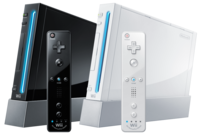 The two most common colors for the Wii | |||||||||||||||
Available colors:
| |||||||||||||||
| Manufacturer | Nintendo | ||||||||||||||
|---|---|---|---|---|---|---|---|---|---|---|---|---|---|---|---|
| Type | Home console | ||||||||||||||
| Release date(s) | |||||||||||||||
| Media | Wii Optical Disc, GameCube Game Disc, Digital distribution | ||||||||||||||
| Input |
| ||||||||||||||
| Predecessor | Nintendo GameCube | ||||||||||||||
| Successor | Wii U | ||||||||||||||
The Wii is a home gaming console and is Nintendo's fifth home gaming console. The Wii became known for its controller, called the Wii Remote, which has motion and tilt sensitivity, and a plug for control extensions on the bottom. The Wii Remote also had a pointer functionality for menu selection, such as managing inventory slots in Animal Crossing: City Folk.
The Wii's original model, featuring GameCube backward compatibility, was released in 2006 and discontinued in 2013. Two redesigned models for the Wii were released: the Wii Family Edition, which was released in 2011 and removed GameCube compatibility, and Wii Mini, a cheaper model with no online connectivity released in 2013. Both revisions have since been discontinued.
The console had a mainline installment in the Animal Crossing series, titled Animal Crossing: City Folk, released on November 16, 2008 in the United States and on December 5 for PAL regions.
The Wii sold 101.63 million[1] units worldwide and held the title of being Nintendo's best selling home console up until 2021 where the Nintendo Switch surpassed it by selling 103.54 million units.
Controllers[edit]
The Wii has various methods of inputting commands like the Wii Remote, Nunchuk, Classic Controller, and the GameCube (GCN) controller. Most games that were released supported these functions by giving the player optional input method like Wii Remote turned horizontally
Special controllers (which are not compatible with Animal Crossing: City Folk) have been released for this console, like the Wii Balance Board, primarily used for the best-selling Wii Fit. The Wii Wheel is a plastic shell that came with Mario Kart Wii that allows the Wii Remote to sit in comfortably and provides the player with a better gaming experience. The Wii Zapper came with Link's Crossbow Training and is primarily used for first-person shooters such as Resident Evil 4. The Wii MotionPlus, was released in June 2009 and was included with Wii Sports Resort. The MotionPlus offers true 1:1 control. It is now built inside the Wii Remote (renamed Wii Remote Plus due to this).
Channels[edit]
Mii Channel[edit]
The Mii Channel is one of the preinstalled channels for the Wii. It is based on a Japanese game. It was released in North America on November 9, 2006, in Japan on December 2, 2006, in Australia on December 7, 2006, and in Europe on December 8, 2006. On the Mii Channel, players can create Miis, virtual characters that can represent them on various games. One of these games is Animal Crossing: City Folk, where players can get a Mii mask at Shampoodle by selecting "Makeover." The first makeover is free, while any more after that cost 3,000 Bells.
Nintendo Channel[edit]
The Nintendo Channel was another channel for the Wii console. It gave players updates on new games and videos. In the City Folk section there were videos to help keep track of current Animal Crossing news. The Nintendo Channel ceased functioning on June 28, 2013, due to the disconnection of WiiConnect24.
[edit]
Wii games[edit]
| Game | Image | Release date(s) |
|---|---|---|
| Super Smash Bros. Brawl | 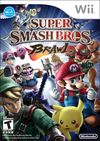 |
|
| Animal Crossing: City Folk | 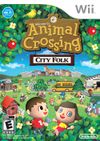 |
Backwards compatibility[edit]
| Game | Image | Release date(s) | Available By |
|---|---|---|---|
| Super Smash Bros. Melee | 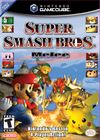 |
GameCube Disc | |
| Doubutsu no Mori+ | 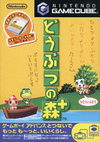 |
GameCube Disc | |
| Animal Crossing | 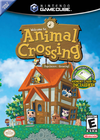 |
GameCube Disc | |
| Doubutsu no Mori e+ | 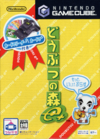 |
GameCube Disc |
Gallery[edit]
In the Animal Crossing series[edit]
Wii Balance Board
(Welcome amiibo)
See also[edit]
External links[edit]
| Nintendo video game consoles | ||||||||||||||
|---|---|---|---|---|---|---|---|---|---|---|---|---|---|---|
| ||||||||||||||
